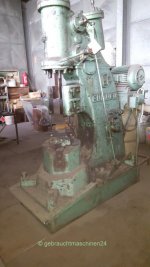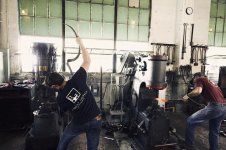opendieforging
Plastic
- Joined
- Apr 19, 2018
Hi Everyone,
I have several pneumatic forging hammers and am purchasing new ones soon that will require installation. Most of them are two piece machines meaning the hammer frame and anvil are separate pieces. Finding a way to mount the anvils totally level is a constant challenge.
Our hammers are slightly larger than the average hobbyist blacksmith but far smaller than the hammers found in modern industry. There are very few production blacksmiths out there any more that are using and installing hammers of this size, so resources are scarce.
The average anvil size is at the base about 2' x 3' and weighs about 5,000 lbs. The average hammer head weight is 300 lbs and strikes 200 times per minute. The entire hammer and anvil are mounted on an isolated foundation about 4'deep with a 1' deep square hole for the anvil. Common practice has always been to put a 1" oak floor in the anvil hole and then place the anvil on top and use wood wedges around the edge of the anvil between it and the edge of the hole for alignment. This is the installation method specified in original drawings, but these machines are about 50-70 years old so i imagine technology has changed a little.
My concerns with this method are:
1) Compression of the oak over time
2) uneven weight distribution because the base of the anvil is rough cast and not flat. Once it is aligned, I imagine only a small area is in contact with the floor.
My thought is to find a pourable product that has very high compressive strength and extreme impact and crack resistance (this is a power hammer after all) that can be poured in the hole first and the anvil can be placed and aligned as the product sets so it cures to provide a perfect fit between uneven concrete and uneven anvil.
What product do you suggest? Or do you possibly have a different solution?
Thanks very much!
I have several pneumatic forging hammers and am purchasing new ones soon that will require installation. Most of them are two piece machines meaning the hammer frame and anvil are separate pieces. Finding a way to mount the anvils totally level is a constant challenge.
Our hammers are slightly larger than the average hobbyist blacksmith but far smaller than the hammers found in modern industry. There are very few production blacksmiths out there any more that are using and installing hammers of this size, so resources are scarce.
The average anvil size is at the base about 2' x 3' and weighs about 5,000 lbs. The average hammer head weight is 300 lbs and strikes 200 times per minute. The entire hammer and anvil are mounted on an isolated foundation about 4'deep with a 1' deep square hole for the anvil. Common practice has always been to put a 1" oak floor in the anvil hole and then place the anvil on top and use wood wedges around the edge of the anvil between it and the edge of the hole for alignment. This is the installation method specified in original drawings, but these machines are about 50-70 years old so i imagine technology has changed a little.
My concerns with this method are:
1) Compression of the oak over time
2) uneven weight distribution because the base of the anvil is rough cast and not flat. Once it is aligned, I imagine only a small area is in contact with the floor.
My thought is to find a pourable product that has very high compressive strength and extreme impact and crack resistance (this is a power hammer after all) that can be poured in the hole first and the anvil can be placed and aligned as the product sets so it cures to provide a perfect fit between uneven concrete and uneven anvil.
What product do you suggest? Or do you possibly have a different solution?
Thanks very much!





